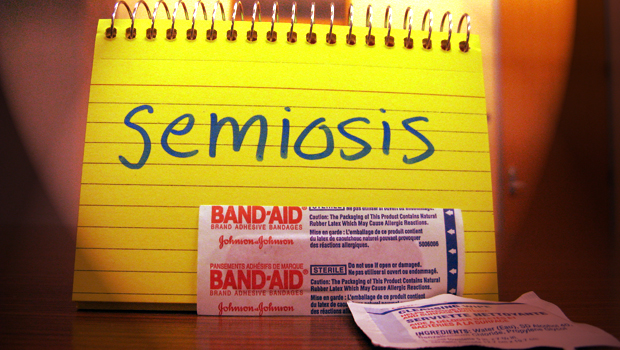

Many of the goals of computers and writing and disability studies intersect. When I think about the TechRhet listserv, the work of Gunther Kress, the vibrant digirhet blogosphere, the work featured in Kairos—or, more realistically, when I think about the emphasis on the sensorial and epistemological possibilities of multimodal composing, of the doors multimodal composing can potentially open for those who make meaning in what are considered nontraditional ways—when I think about all of these things, the overlaps with disability studies seem so obvious. At root, I think, both areas of inquiry (C&W and DS) are concerned with access, with opening up possibilities.
But the problem is this: Access, as we've come to represent it in the field, functions as a narrative of remediation and erasure. Within disability contexts, much of our scholarship positions access(ibility) as a project of rehabilitation. That is, there is a set of able-bodied us's eagerly waiting to rescue a few, rare disabled thems who are in dire need of help.
Some of our most foundational scholarly texts operate on this very assumption, even those we might deem progressive or prescient in their calls for radical inclusivity. One of the most frequently cited texts on multimodality and access, the New London Group's (NLG) work on multiliteracies embodies this accommodative narrative. To put it bluntly: the Designer in the NLG's theory of capital-d Design is unmistakably able-bodied. Despite all of their discussion on norming difference and developing a pedagogy of access, Design theory is primarily of use to individuals with a stock neurological configuration—that is, a neurologically typical brain. Consider, for example, how the NLG's (2000) promotion of multiliteracies curricula directs our attention:
there will be a cognitive benefit to all children in a pedagogy of linguistic and cultural pluralism, including for 'mainstream' children. When learners juxtapose different languages, discourses, styles, and approaches, they gain substantively in metacognitive and metalinguistic abilities and in their ability to reflect critically on complex systems and their interactions (p. 15). [emphasis mine]
The language of cognitive benefit and cognitive ability is dangerous language, especially when implicit comparisons are made between mainstream students and the Hidden Others (that is, presumably those students enrolled in special education courses, or students who are otherwise segregated from public schools for disability-related reasons). What to make of the assumptions behind this statement—that a pedagogy of multiliteracies benefits even the mainstream kids, so we know that emphasizing pluralism has to be a good thing? What if such a pedagogical move were only of benefit to non-mainstream children, to children with vision impairments or children with developmental disabilities? What then? Another essay for another, more special book collection?
Accommodation, I'd suggest, presumes that disabled people do not exist unless they reveal themselves—at which point, they need able-bodied people to help them assimilate. In a more recent representation of multimodality and disability, James Porter (2009) likewise promoted accessible design practices via a framework of accommodation. In his attempt to foreground the exigency of access, he urged the following:
In other words, the reason to write/design for accessibility is not only to enable people with disabilities to consume information but to help them produce it. (p. 216)
While I'm heartened that Porter emphasized one incredibly important facet of universal design and the disability rights movement—that is, participatory design, or inclusion of  disabled individuals in the process of designing—I'm stuck, in particular, on one word in Porter's sentence: help. What's of note here is the implicit separation between ability and disability. Porter is imploring his readers to design accessibly so that they can help disabled people produce their own work. In the process, however, he presumes an audience of able-bodied helpers—reinforcing the idea that access involves tinkering with normative conditions in order to squeeze in non-normative others.
disabled individuals in the process of designing—I'm stuck, in particular, on one word in Porter's sentence: help. What's of note here is the implicit separation between ability and disability. Porter is imploring his readers to design accessibly so that they can help disabled people produce their own work. In the process, however, he presumes an audience of able-bodied helpers—reinforcing the idea that access involves tinkering with normative conditions in order to squeeze in non-normative others.
This issue of accommodation, I feel, is one area where Disability Studies can productively complicate multimodal theories of composing. I'd like to draw upon Jason Palmeri's (2006) work—in particular, his characterization of technical communication as a "rehabilitative profession" (p. 55), a profession in which the non-disabled take it as their task to help disabled people access already existing artifacts. Palmeri warned us that this rehabilitative focus positions technical communicators as
experts who assist those with disabilities in accessing information. In this way, disability is constructed as something to be accommodated (a much better move than something to be ignored), but is not yet seen as "enabling insight—critical, experiential, cognitive, and sensory" (qtd, Brueggemann, 2002, p. 21). (p. 55)
A rehab approach to accommodation is clearly problematic, a problem that extends to C&W and many fields beyond. A rehab approach to accessibility positions disabled people as passive recipients. It creates an us/them divide between the able-bodied savior-designers and the disabled victim-users. It positions disability outside the scope of design or co-production, some of our dearest concepts. If you listen for this assumption, you will hear it all the time: for example, the statement made at one of Computers & Writing's Town Hall meetings in 2011, that we should remember not everyone can access the new, cutting-edge technologies that we access.
So, in a word, accommodation, in all of its reasonableness, is a bandaid, what my co-authors have categorized as a retrofit. But what's most important for us to recognize, I think, is the sense of shame that accommodation reinforces. It implies that there exists a natural or reasonable system, and that our minds and our bodies are somehow lacking because we cannot fit into this natural system. Moreover, shame lessens opportunities for true co-production in the design of material, virtual, and social infrastructures, creating, instead, opportunities for tokenization rather than for participatory design.